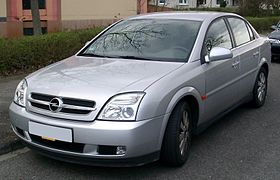Vauxhall Vectra
| Opel Vectra | |
|---|---|

Opel Vectra C (facelift)
|
|
| Overview | |
| Manufacturer | Opel (General Motors) |
| Production | 1988–2008 |
| Body and chassis | |
| Class | Large family car (D) |
| Chronology | |
| Predecessor | Opel Ascona |
| Successor | Opel Insignia |
| Vectra A | |
|---|---|
 |
|
| Overview | |
| Also called | Chevrolet Vectra Holden Vectra (New Zealand) Vauxhall Cavalier |
| Production | 1988–1995 |
| Assembly |
Luton, England Antwerp, Belgium Eisenach, Germany Rüsselsheim, Germany São Caetano do Sul, Brazil Caracas, Venezuela 6th of October City, Egypt (GM Egypt) |
| Designer | Wayne Cherry |
| Body and chassis | |
| Body style | 4-door saloon 5-door liftback |
| Layout | Front-engine, front-wheel-drive or four-wheel-drive |
| Platform | GM2900 platform |
| Related | Opel Calibra |
| Powertrain | |
| Engine |
|
| Transmission | 5-speed manual (F10/5, F13/5, F16/5, F20/5) 6-speed Getrag manual (F28/6) 4-speed automatic |
| Dimensions | |
| Wheelbase | 2,600 mm (102.4 in) |
| Length | 4,430 mm (174.4 in) (saloon) 4,350 mm (171.3 in) (hatch) |
| Width | 1,700 mm (66.9 in) |
| Height | 1,400 mm (55.1 in) |
| Curb weight | 997–1,199 kg (2,198–2,643 lb) (4-cyl petrols) |
| Vectra B | |
|---|---|
 |
|
| Overview | |
| Also called | Chevrolet Vectra Holden Vectra Vauxhall Vectra |
| Production | 1995–2002 |
| Assembly |
Ellesmere Port, England Luton, England Rüsselsheim, Germany Antwerp, Belgium 6th of October City, Egypt (1998–2002) (GM Egypt) Elizabeth, S.A., Australia (1998–1999) São Caetano do Sul (1996–2005), Brazil İzmir, Turkey (1996–2002) |
| Body and chassis | |
| Body style | 4-door saloon 5-door liftback 5-door estate |
| Platform | GM2900 platform |
| Related | Saturn L-Series |
| Powertrain | |
| Engine | |
| Transmission | 4-speed automatic 5-speed manual |
| Dimensions | |
| Wheelbase | 2,640 millimetres (104 in) |
| Length | 4,480 millimetres (176 in) (saloon/liftback) 4,490 millimetres (177 in) (estate) |
| Width | 1,710 millimetres (67 in) |
| Height | 1,420 millimetres (56 in) |
| Curb weight | 1,270 kilograms (2,800 lb)–1,325 kilograms (2,921 lb) |
| Vectra C | |
|---|---|
 |
|
| Overview | |
| Also called | Chevrolet Vectra Holden Vectra Vauxhall Vectra |
| Production | 2002–2008 |
| Assembly |
Ellesmere Port, England Rüsselsheim, Germany 6th of October City, Egypt (GM Egypt) |
| Body and chassis | |
| Body style | 4-door saloon 5-door liftback 5-door estate |
| Platform | Epsilon platform |
| Related | Opel Signum |
| Powertrain | |
| Engine | |
| Transmission | 6-speed automatic 6-speed manual 5-speed manual Easytronic CVTronic |
| Dimensions | |
| Wheelbase | 2,700 mm (106.3 in) (saloon/hatch) 2,830 millimetres (111 in) (estate) |
| Length | 4,596 mm (180.9 in) (saloon/hatch, pre-facelift) 4,611 mm (181.5 in) (saloon/hatch, post-facelift) 4,822 mm (189.8 in) (estate, pre-facelift) 4,839 mm (190.5 in) (estate, post-facelift) "OPC" versions 31 mm (1.2 in) longer |
| Width | 1,798 mm (70.8 in) |
| Height | 1,460 mm (57.5 in) (saloon/hatch) 1,500 mm (59.1 in) (estate) |
| Curb weight | 1,393 kg (3,071 lb) |
The Opel Vectra was a large family car that was engineered and produced by the German automaker Opel. In the United Kingdom, the car was sold under the Vauxhall marque as the Vauxhall Cavalier and later as the Vauxhall Vectra, from 1995 onwards. It has also been sold by Holden in Australasia as Holden Vectra, and by Chevrolet in Latin America as the Chevrolet Vectra.
The Vectra was introduced in October 1988 as a replacement to the Opel Ascona, and itself was replaced in 2009 by the Opel Insignia, the nameplate spanning twenty one years and three generations of car.
The first generation Vectra, known as the Vectra A, was introduced in October 1988, as a saloon and hatchback, replacing the Opel Ascona C. A coupé based on the Vectra, called the Calibra, was introduced the following year. Both cars were designed by the Opel design chief at the time, Wayne Cherry. Vauxhall Motors, the British GM subsidiary that shared most of its models with Opel, did not use the "Vectra" model name until Vauxhall introduced the name into the United Kingdom in August 1995. The 1989 Vectra came in Base, LS, GL, GLS, CD, and GT models, its sister model was the third generation Cavalier.
Engines ranged initially from a 75 PS (55 kW) 1.4 L to a 130 PS (96 kW) 2.0 L Family II. With the introduction of Euro I emissions regulations, the base model was replaced by a 1.6 L with the same output, while the top of the line was given to a 16-valve version of the 2.0 L engine, which powered the GT (GSI) version, and had 150 PS (110 kW). Four-wheel drive versions were added to the lineup in 1990, and in 1993, the car received a limited edition turbocharged version, with 204 PS (150 kW). The 1.4-litre engine was not available in all markets, and even then, it was only available in basic trims (Base/L in United Kingdom, LS/GL in Europe). A 2.5 L V6 engine appeared towards the later stages of the Vectra's life, developing 170 PS (125 kW), turning the car into a relaxed motorway cruiser rather than giving it sporty pretensions.
...
Wikipedia
